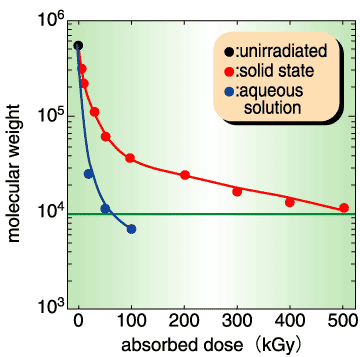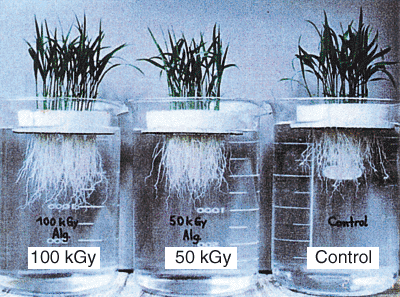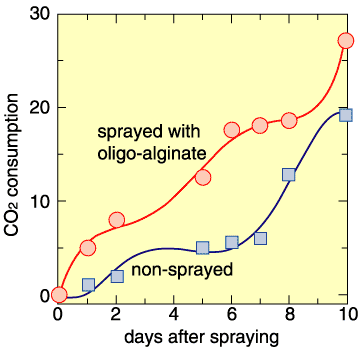Natural polysaccharides with high molecular weight like alginate and chitosan, which are found in seaweed and crustaceans, are widely utilized in food, pharmaceutical and bioengineering industries. Recently, oligo-saccharides derived from the depolymer-ization of polysaccharides by enzyme
reaction were shown to have novel features such as the enhancement of antibiosis, promotion of germination and root elongation of plants. We have studied radiation-induced depolymerization caused by chain scission, which is one of the characteristics
of the effect of radiation on organic materials, and clarified that the oligo-saccharides obtained by this radiation method have excellent functions.
When organic materials are irradiated by ionizing radiation, they are divided to two types, i.e., degradation (chain scission) type and chain link (crosslinking) type. Alginate is classified as a degradation type (Fig. 5-5). To confirm the plant growth promotion effect, the oligo-alginate prepared by radiation-induced depolymerization was supplied to rice through a hydroponic solution. A clear promotion effect can be seen (Fig. 5-6). In the case of peanuts, the effect was examined by using the method of spraying oligo-alginate to the foliar after 30 days of cultivation. By the spraying of the solution, which contained with 100 ppm of the oligo-alginate obtained by 100 kGy gamma-ray irradiation, 60% of growth promotion was confirmed after 15 days of spraying. Figure 5-7 is the result of the promotion of photosynthesis. The increases in biochemical and physiological function are confirmed. Moreover, it has been confirmed in field tests for peanut, tea, carrot and cabbage, that productivity increases 15-40% by using a solution with 20-100 ppm of oligo-alginate. Chitosan is also depolymerized by gamma-ray irradiation and growth promotion of the plant has been confirmed. |


